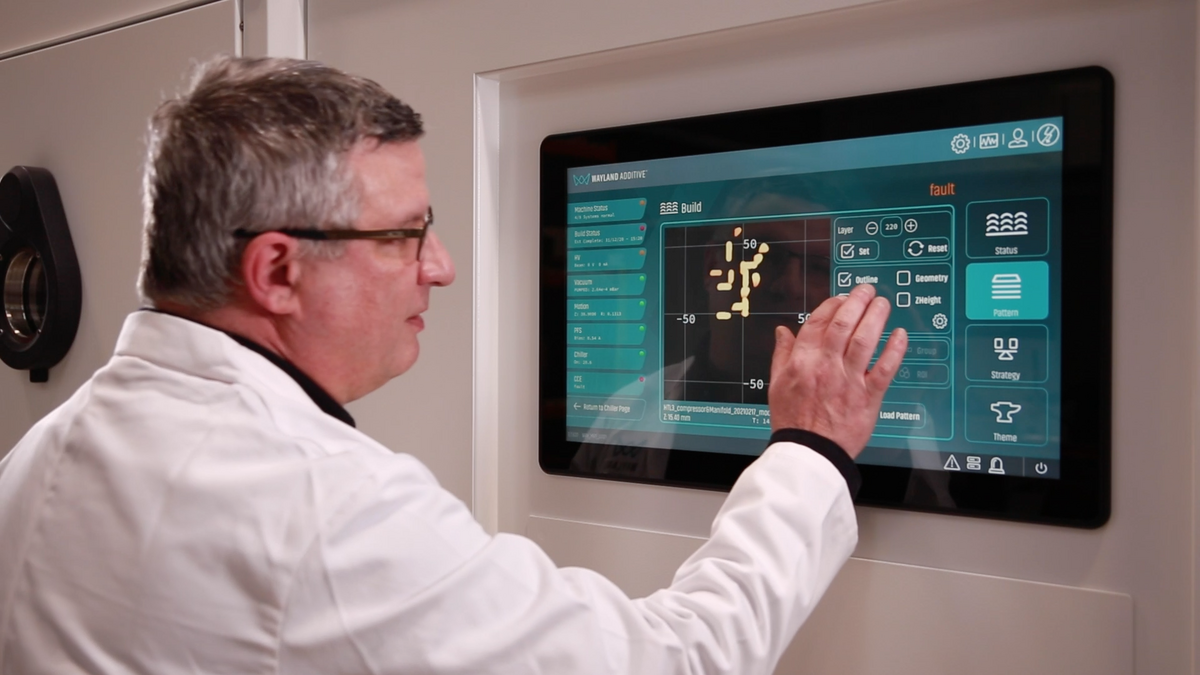— Wayland’s Calibur3 offers optimized powder delivery and reduced material waste
(26th May 2021, Huddersfield, U.K.) Metal additive manufacturing (AM) is a process with demanding requirements for in-process material management, specifically with regard to the use of powdered metals. The Calibur3 system from Wayland additive which is enabled by the NeuBeam® process not only redefines how the electron beam (eBeam) process can be applied in a more stable and flexible way, but also offers a number of unprecedented powder dispense capabilities for metal AM.
The Calibur3 system allows users to measure powder dispensing and flowability to optimise powder usage and to extend overall powder recycling to achieve greater economies of scale. There is an animation HERE.
The growth of Wayland Additive has seen specific personnel brought on board to further the development of the NeuBeam® process and the Calibur3 system and the capabilities it can offer. Specific attention has been given to the disciplines of material science and mechanical engineering.
The latter has resulted in a real breakthrough with the powder dispensing and spreading mechanism that has been designed and developed for the NeuBeam® process. The mechanical engineering team has developed this mechanism in parallel with the implementation of the structured light scanning process — one of three in-process monitoring systems — that are embedded in the Calibur3. Together this dual approach has facilitated an innovative powder dispense system that provides optimal results in a number of key ways.
For each build layer, the Calibur3 system ensures that the powder is dispensed from a nozzle to create a powder heap — shaped like a ridge — at the side of the powder bed. The Wayland development team has characterized the relationship between the flowability of the powder and the amount of powder dispensed. As a result, a proprietary (and patent-pending) mechanism controls the amount of powder that is dispensed for each layer by controlling the distance between the nozzle and the powder bed.
This means that a consistent and optimal volume of powder can be dispensed and dispersed across the top of the powder bed even if there is drift in the flowability of the powder from build to build, or even within the same build. It also means that users can easily adapt the system to work with powders with different flowability, and predict the performance of the powder in the Calibur3 by applying a simple flowability test.
Furthermore, once the powder has been dispensed, the volume of powder for that layer can be measured and monitored using the Calibur3 structured light scanning in-process monitoring system. This process involves 3D scanning the shape of the powder heap dispensed and provides an accurate real-time measurement of the powder in cubic centimeters. This data enables full control of the amount of powder that is dispensed for each layer. For example, if too little powder is being dispensed, then the system will pick this up, and the dispense volume can be increased on subsequent layers – or vice versa.
An additional function of the dispersal mechanism optimizes powder usage even further. As with all powder bed fusion processes, the powder is spread across the top of the powder bed with a single pass of the recoater. At the end of the spread, inevitably there is some residual powder left over, which on the Calibur3 is then used to spread the subsequent layer. The Wayland team has developed a further patent-pending bi-directional recoating method that not only enables this subsequent pass using the residual powder from the previous pass, but also adds optimised dosing to the residual powder heap from the controlled volume dispenser. To put it another way, the Calibur3 features a self-regulating powder dispensing mechanism that does not spread excess powder into an overflow like most other systems on the market. This in turn means that less powder is needed in the machine to complete a build, and it significantly reduces material waste.
Will Richardson, CEO of Wayland Additive commented, “The new Calibur3 metal AM system clearly displays the holistic and intelligent approach of the first class team of experts we have assembled — and continue to assemble — at Wayland. It is hard to over-emphasize the innovation and hard work that the team has put in to the new capabilities featured in the NeuBeam® process. It has been the result of starting from scratch, building a new system from the ground up, with a cross-discipline approach. As we commercially launch Calibur3 in the next weeks, I am confident that the results will speak for themselves and our partners will start to see the benefits in real terms.”








